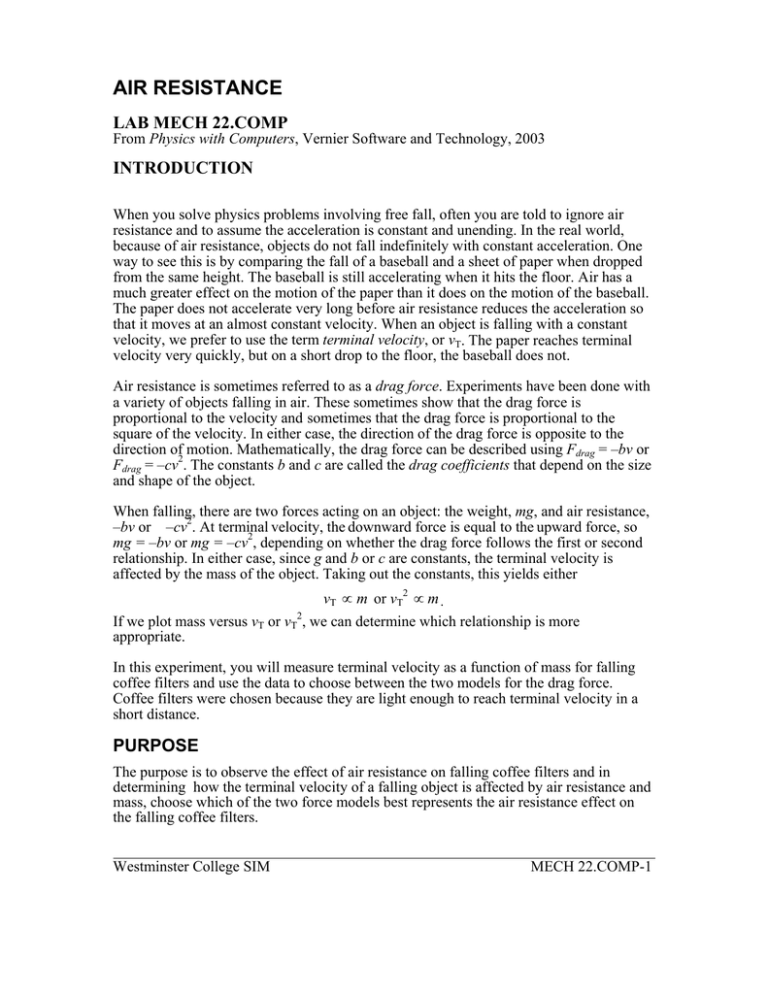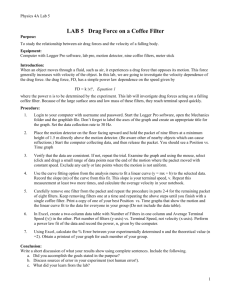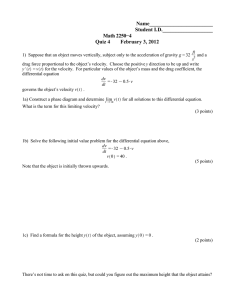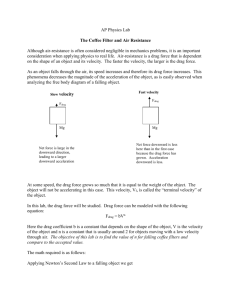AIR RESISTANCE LAB MECH 22.COMP INTRODUCTION
advertisement

AIR RESISTANCE LAB MECH 22.COMP From Physics with Computers, Vernier Software and Technology, 2003 INTRODUCTION When you solve physics problems involving free fall, often you are told to ignore air resistance and to assume the acceleration is constant and unending. In the real world, because of air resistance, objects do not fall indefinitely with constant acceleration. One way to see this is by comparing the fall of a baseball and a sheet of paper when dropped from the same height. The baseball is still accelerating when it hits the floor. Air has a much greater effect on the motion of the paper than it does on the motion of the baseball. The paper does not accelerate very long before air resistance reduces the acceleration so that it moves at an almost constant velocity. When an object is falling with a constant velocity, we prefer to use the term terminal velocity, or vT. The paper reaches terminal velocity very quickly, but on a short drop to the floor, the baseball does not. Air resistance is sometimes referred to as a drag force. Experiments have been done with a variety of objects falling in air. These sometimes show that the drag force is proportional to the velocity and sometimes that the drag force is proportional to the square of the velocity. In either case, the direction of the drag force is opposite to the direction of motion. Mathematically, the drag force can be described using Fdrag = –bv or Fdrag = –cv2. The constants b and c are called the drag coefficients that depend on the size and shape of the object. When falling, there are two forces acting on an object: the weight, mg, and air resistance, –bv or –cv2. At terminal velocity, the downward force is equal to the upward force, so mg = –bv or mg = –cv2, depending on whether the drag force follows the first or second relationship. In either case, since g and b or c are constants, the terminal velocity is affected by the mass of the object. Taking out the constants, this yields either vT ∝ m or vT2 ∝ m . 2 If we plot mass versus vT or vT , we can determine which relationship is more appropriate. In this experiment, you will measure terminal velocity as a function of mass for falling coffee filters and use the data to choose between the two models for the drag force. Coffee filters were chosen because they are light enough to reach terminal velocity in a short distance. PURPOSE The purpose is to observe the effect of air resistance on falling coffee filters and in determining how the terminal velocity of a falling object is affected by air resistance and mass, choose which of the two force models best represents the air resistance effect on the falling coffee filters. Westminster College SIM MECH 22.COMP-1 Air Resistance MATERIALS Computer Vernier computer interface Logger Pro Vernier Motion Detector 5 basket-style coffee filters Graphical Analysis or graph paper PRELIMINARY QUESTIONS 1. Hold a single coffee filter in your hand. Release it and watch it fall to the ground. Next, nest two filters and release them. Did two filters fall faster, slower, or at the same rate as one filter? What kind of mathematical relationship do you predict will exist between the velocity of fall and the number of filters? 2. If there were no air resistance, how would the rate of fall of a coffee filter compare to the rate of fall of a baseball? 3. Sketch a graph of the velocity vs. time for one falling coffee filter. 4. When the filter reaches terminal velocity, what is the net force acting upon it? PROCEDURE 1. Connect the Motion Detector to the DIG/SONIC 1 channel of the interface. Motion Detector 2. Support the Motion Detector about 2 m above the floor, pointing down, as shown in Figure 1. 3. Open the file “13 Air Resistance” from the Physics with Computers folder. 4. Place a coffee filter in the palm of your hand and hold it about 0.5 m under the Motion Detector. Do not hold the filter closer than 0.4 m. Interface to begin data collection. 5. Click When the Motion Detector begins to click, release the coffee filter directly below the Motion Detector so that it falls toward the floor. Move your hand out of the beam of the Motion Detector as quickly as possible so that only the motion of the filter is recorded on the graph. Figure 1 Westminster College SIM MECH 22.COMP-2 Air Resistance 6. If the motion of the filter was too erratic to get a smooth graph, repeat the measurement. With practice, the filter will fall almost straight down with little sideways motion. 7. The velocity of the coffee filter can be determined from the slope of the position vs. time graph. At the start of the graph, there should be a region of increasing slope (increasing velocity), and then it should become linear. Since the slope of this line is velocity, the linear portion indicates that the filter was falling with a constant or terminal velocity (vT) during that time. Drag your mouse pointer to select the portion of the graph that appears the most linear. Determine the slope by clicking the Linear Fit button, . 8. Record the slope in the data table (a velocity in m/s). 9. Repeat Steps 4 – 8 for two, three, four, and five coffee filters. DATA TABLE Number of filters Terminal Velocity vT (m/s) (Terminal Velocity)2 vT2 (m2/s2) 1 2 3 4 5 ANALYSIS 1. To help choose between the two models for the drag force, plot terminal velocity vT vs. number of filters (mass). On a separate graph, plot vT2 vs. number of filters. Use either Logger Pro or graph paper. 2. During terminal velocity the drag force is equal to the weight (mg) of the filter. If the drag force is proportional to velocity, then vT ∝ m . Or, if the drag force is proportional to the square of velocity, then vT2 ∝ m . From your graphs, which proportionality is consistent with your data; that is, which graph is closer to a straight line that goes through the origin? 3. From the choice of proportionalities in the previous step, which of the drag force 2 relationships (– bv or – cv ) appears to model the real data better? Notice that you are choosing between two different descriptions of air resistance—one or both may not correspond to what you observed. 4. How does the time of fall relate to the weight (mg) of the coffee filters (drag force)? If one filter falls in time, t, how long would it take four filters to fall, assuming the filters are always moving at terminal velocity? Westminster College SIM MECH22.COMP-3 Air Resistance EXTENSIONS 1. Make a small parachute and use the Motion Detector to analyze the air resistance and terminal velocity as the weight suspended from the chute increases. 2. Draw a free body diagram of a falling coffee filter. There are only two forces acting on the filter. Once the terminal velocity vT has been reached, the acceleration is zero, so the net force, ∑ F = ma = 0, must also be zero ∑ F = − mg + bvT = 0 or ∑ F = − mg + cvT 2 = 0 depending on which drag force model you use. Given this, sketch plots for the terminal velocity (y-axis) as a function of filter weight for each model (x-axis). (Hint: Solve for vT first.) Westminster College SIM MECH 22.COMP-4






